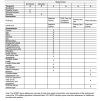The Impact of Previsit Contextual Data Collection on Patient-Provider Communication and Patient Activation: Study Protocol for a Randomized Controlled Trial
- PMID: 32965223
- PMCID: PMC7542405
- DOI: 10.2196/20309
The Impact of Previsit Contextual Data Collection on Patient-Provider Communication and Patient Activation: Study Protocol for a Randomized Controlled Trial
Abstract
Background: Patient-centered care is respectful of and responsive to individual patient preferences, needs, and values. To provide patient-centered care, clinicians need to know and incorporate patients' context into their communication and care with patients. Patient contextual data (PCD) encompass social determinants of health and patients' needs, values, goals, and preferences relevant to their care. PCD can be challenging to collect as a routine component of the time-limited primary care visit.
Objective: This study aims to determine if patient-provider communication and patient activation are different for patient users and patient nonusers of an electronic health record (EHR)-integrated PCD tool and assess if the impact of using PCD on patient-provider communication and patient activation differs for Black and White patients.
Methods: We describe a randomized controlled trial of a prospective cohort of non-Hispanic White and Black patients who receive primary care services at a midwestern academic health care system in the United States. We will evaluate whether providing PCD through a consumer informatics tool enhances patient-provider communication, as measured by the Communication Assessment Tool, and we will evaluate patient activation, as measured by the Patient Activation Measure for PCD tool users and nonusers. Furthermore, owing to racial disparities in care and communication, we seek to determine if the adoption and use of the tool might narrow the differences between patient groups.
Results: The trial was funded in November 2017 and received local ethics review approval in February 2019. The study began recruitment in April 2019 and enrollment concluded in October 2019 with 301 participants. The analysis was completed in May 2020, and trial results are expected to be published in winter 2020.
Conclusions: Recently, there has been increased attention to the role of health information technology tools to enable patients to collaborate with providers through the sharing of PCD. The adoption of such tools may overcome the barriers of current EHRs by directly engaging patients to submit their contextual data. Effectively, these tools would support the EHR in providing a more holistic understanding of the patient. Research further supports that individuals who have robust digital engagement using consumer informatics tools have higher participation in treatment follow-up and self-care across populations. Therefore, it is critical to investigate interventions that elicit and share patients' social risks and care preferences with the health care team as a mechanism to improve individualized care and reduce the gap in health outcomes.
Trial registration: ClinicalTrials.gov NCT03766841; https://clinicaltrials.gov/ct2/show/NCT03766841.
International registered report identifier (irrid): RR1-10.2196/20309.
Keywords: consumer health informatics; mobile phone; patient participation; patient-centered care; physician-patient relations; randomized controlled trial; vulnerable populations.
©Jeana M Holt, Rachel Cusatis, Aaron Winn, Onur Asan, Charles Spanbauer, Joni S Williams, Kathryn E Flynn, Melek Somai, Purushottam Laud, Bradley H Crotty. Originally published in JMIR Research Protocols (http://www.researchprotocols.org), 23.09.2020.
Conflict of interest statement
Conflicts of Interest: None declared.
Figures
Similar articles
-
Impact of Pre-visit Contextual Data Collection on Patient-Physician Communication and Patient Activation: a Randomized Trial.J Gen Intern Med. 2021 Nov;36(11):3321-3329. doi: 10.1007/s11606-020-06583-7. Epub 2021 Feb 9. J Gen Intern Med. 2021. PMID: 33559067 Free PMC article. Clinical Trial.
-
Implementation of Patient Engagement Tools in Electronic Health Records to Enhance Patient-Centered Communication: Protocol for Feasibility Evaluation and Preliminary Results.JMIR Res Protoc. 2021 Aug 26;10(8):e30431. doi: 10.2196/30431. JMIR Res Protoc. 2021. PMID: 34435960 Free PMC article.
-
Real-world implementation evaluation of an electronic health record-integrated consumer informatics tool that collects patient-generated contextual data.Int J Med Inform. 2022 Sep;165:104810. doi: 10.1016/j.ijmedinf.2022.104810. Epub 2022 Jun 11. Int J Med Inform. 2022. PMID: 35714549
-
Adult patient access to electronic health records.Cochrane Database Syst Rev. 2021 Feb 26;2(2):CD012707. doi: 10.1002/14651858.CD012707.pub2. Cochrane Database Syst Rev. 2021. PMID: 33634854 Free PMC article.
-
Health care providers’ role in protecting EHRs: Implications for consumer support of EHRs, HIE and patient-provider communication.2014 Feb. In: ASTP Health IT Data Brief [Internet]. Washington (DC): Office of the Assistant Secretary for Technology Policy; 2012. 15. 2014 Feb. In: ASTP Health IT Data Brief [Internet]. Washington (DC): Office of the Assistant Secretary for Technology Policy; 2012. 15. PMID: 40127351 Free Books & Documents. Review.
Cited by
-
Impact of Pre-visit Contextual Data Collection on Patient-Physician Communication and Patient Activation: a Randomized Trial.J Gen Intern Med. 2021 Nov;36(11):3321-3329. doi: 10.1007/s11606-020-06583-7. Epub 2021 Feb 9. J Gen Intern Med. 2021. PMID: 33559067 Free PMC article. Clinical Trial.
-
Patient-Clinician Communication Interventions Across Multiple Primary Care Sites: A Cluster Randomized Clinical Trial.JAMA Health Forum. 2024 Dec 6;5(12):e244436. doi: 10.1001/jamahealthforum.2024.4436. JAMA Health Forum. 2024. PMID: 39671203 Free PMC article. Clinical Trial.
References
-
- Dzau VJ, McClellan MB, McGinnis JM, Burke SP, Coye MJ, Diaz A, Daschle TA, Frist WH, Gaines M, Hamburg MA, Henney JE, Kumanyika S, Leavitt MO, Parker RM, Sandy LG, Schaeffer LD, Steele GD, Thompson P, Zerhouni E. Vital directions for health and health care: priorities from a national academy of medicine initiative. J Am Med Assoc. 2017 Apr 11;317(14):1461–70. doi: 10.1001/jama.2017.1964. - DOI - PubMed
-
- Epstein RM, Street RL. The values and value of patient-centered care. Ann Fam Med. 2011;9(2):100–3. doi: 10.1370/afm.1239. http://www.annfammed.org/cgi/pmidlookup?view=long&pmid=21403134 - DOI - PMC - PubMed
-
- Institute of Medicine . Crossing the Quality Chasm: A New Health System for the 21st Century. Washington, DC: The National Academies Press; 2001. - PubMed
-
- World Health Organization . Social Determinants of Health: The Solid Facts. Denmark, UK: WHO Regional Office for Europe; 2003.
-
- Holt JM, Cusatis R, Asan O, Williams J, Nukuna S, Flynn KE, Moore J, Crotty BH. Incorporating patient-generated contextual data into care: clinician perspectives using the consolidated framework for implementation science. Healthc (Amst) 2020 Mar;8(1):100369. doi: 10.1016/j.hjdsi.2019.100369. - DOI - PubMed
Associated data
LinkOut - more resources
Full Text Sources
Medical
Miscellaneous




